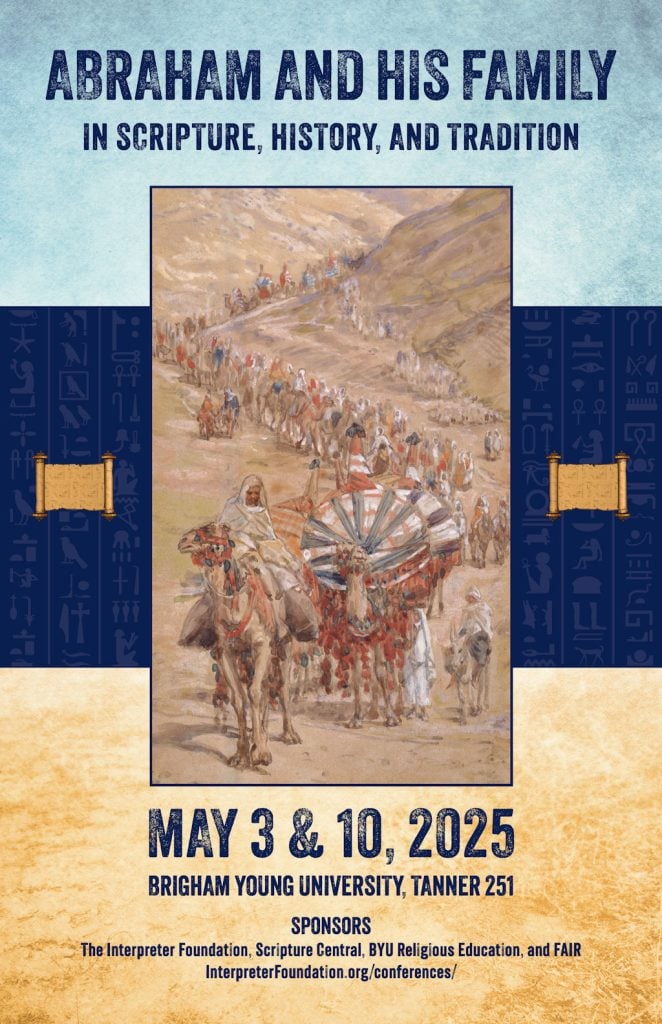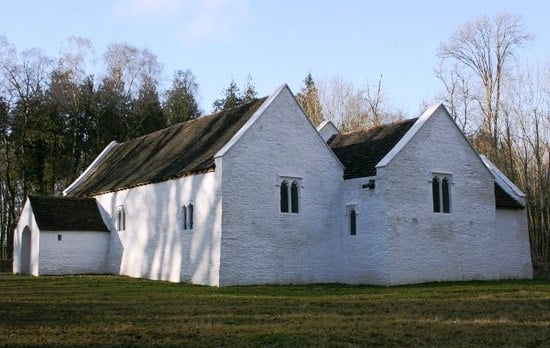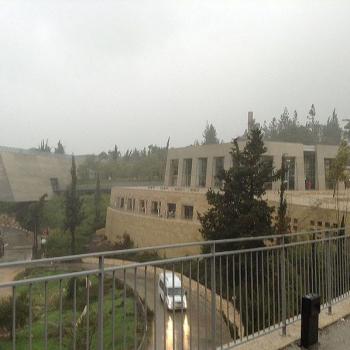
I’m very pleased to report that video- and audio recordings of the recent Interpreter Foundation conference on “Abraham and His Family in Scripture, History, and Tradition” — which was held on the campus of Brigham Young University on two successive Saturdays (3 May 2025 and 10 May 2025) — are now available on the Interpreter Foundation’s website. I hope that you will enjoy them.
I also call your attention to the latest installment in an ongoing series of Interpreter Foundation blog entries by Brant A. Gardner. This new one is entitled “The Heartland Versus Mesoamerica: Part 6: Narrow Necks and Small Necks.”
St. Teilo’s Church at the St. Fagans open air museum in Cardiff, Wales (Wikimedia Commons public domain image)We spent our morning at the St. Fagans National Museum of History here in Cardiff. It’s mostly an open-air museum dedicated to the national heritage of Wales, and it features a large number of representative historic buildings — including a round structure that was once used for cockfights. That structure offered a chance to talk a bit further about the much larger cockpit in Preston, where some of the first Latter-day Saint meetings were held. My favorite part of the visit, though, was St. Teilo’s Church, which, although it has been altered and extended considerably since then, is believed to have been built originally during the late twelfth or early thirteenth century. It has been refurbished as it may have appeared about the year 1530, in the style of a late medieval Catholic church, including a rood screen, altars, carvings, and — I really enjoyed these — brightly-colored paintings on all of the walls.
We then went to the “Big Pit” (Pwll Mawr) in Blaenavon, Torfaen, which was a working coal mine from either 1860 (according to our guide on the site) or 1880 (according to Wikipedia) until 1980. It is now an industrial heritage museum — officially, the “Big Pit National Coal Museum.” We spent about an hour in the mine itself, three hundred feet below the surface, learning about mining methods and the lives of coal miners (more properly, of “colliers”) and the children and pit ponies who worked with them underground. I would not willingly have traded places with them. My wife and I instantly recognized our guide, Steve, as the same fellow who took us around the mine during our previous Latter-day Saint tour group here, several years ago. Retired from thirty-five years as a collier, he is a classic character, with a rich Welsh wit.
After leaving Pwll Mawr, we drove back to Cardiff via Merthyr Tydfil, with Peter Fagg outlining the history of the Church of Jesus Christ of Latter-day Saints in Wales along the way.

He gave particular attention to Dan Jones, who was born in northeastern Wales in 1810. In 1840, Jones and his wife emigrated to the United States, where he soon became a steamship captain on the Mississippi, first of the Ripple and then of the Maid of Iowa. In January 1843, he was baptized into the Church.
In June of 1844, when Joseph Smith and Hyrum Smith were arrested and imprisoned in Carthage Jail, Dan Jones was selected, along with Elders Willard Richards and John Taylor of the Twelve, to accompany the Smiths to the jail in order to provide them with support and protection. The night before Joseph and Hyrum were killed, the Prophet (clearly sensing that this might be the end) asked Jones if he was afraid to die, to which Jones responded, “Has that time come, think you? Engaged in such a cause, I do not think that death would have many terrors.” The Prophet replied with what some have identified as his “last prophecy”: “You will yet see Wales,” Joseph promised him, “and fulfill the mission appointed you before you die.” As it turned out, Dan Jones was not in Carthage Jail at the time of the martyrdom of Joseph and Hyrum Smith: He had left the jail with the assignment of delivering a letter to Orville H. Browning, who was a potential defense attorney for the brothers.
In late 1844, Brigham Young asked Jones to return to the British Isles as a missionary for the Church. So he and his wife traveled with Wilford Woodruff and a number of other missionaries back across the Atlantic Ocean. After approximately one year in Britain and with relatively little success to show for his labors, Jones was asked to preside over the missionary efforts in Wales. At this time, there were just over two hundred Latter-day Saints in Wales but, under his leadership, the missionaries in Wales baptized approximately 3600 people between 1845 and 1848.
In 1846, Jones — who was a prolific writer, an ardent controversialist, and, evidently, a powerful preacher — began to publish a Welsh-language periodical for the Church entitled Prophet of the Jubilee (Prophwyd y Jubili). It was the first Latter-day Saint periodical ever to be published in a language other than English. In 1847, Jones published the most famous of his many Welsh-language pamphlets and tracts: “Hanes Saint y Dyddiau Diweddaf” (“History of the Latter-day Saints”). It has been estimated that one out of every 278 people in Wales at that time had been baptized as a Latter-day Saint and, when he returned to the United States early in 1849 with over three hundred Welsh converts, there were seventy-two branches of the Church in Wales and 4645 Latter-day Saints.
Dan Jones served as the president of a Welsh-speaking branch of the Church at Council Bluffs, Iowa, and finally arrived in the Valley of the Great Salt Lake late in October 1849. He then settled in Manti, where he was elected mayor in 1851. But he didn’t stay long. In 1852, Brigham Young asked him to return to Wales for a second stint as a missionary. He served there until 1856, baptizing approximately 2000 persons in Wales, most of whom eventually immigrated to Utah. In 1852, he supervised translation of the Book of Mormon into Welsh — only the third non-English language (after Danish and French) in which the book had been published. He also briefly edited Udgorn Seion, the Welsh-language Church periodical that had taken the place of his own Prophwyd y Jubili.
Shortly after his return to Utah in 1856, Jones’s health began to deteriorate, and, on 3 January 1862, he died of tuberculosis in Murray. He is buried in the Provo City Cemetery.
President Gordon B. Hinckley once declared that Dan Jones “must certainly be included in the half dozen or so most productive missionaries in the history of the Church.” Thus, it’s appropriate that one of the dormitories at the Missionary Training Center in Provo, Utah, is called the “Dan Jones Building.”
Evan Stephens, who was born in Pencader, Wales, in 1854, emigrated to Utah with his parents at the age of twelve. He directed the Tabernacle Choir from 1890 to 1916 and was also important as a composer and hymn writer. According to Wikipedia, his contributions to the 1985 hymnal of the Church of Jesus Christ of Latter-day Saints numbered eighteen, as follows:
- No. 11 “What Was Witnessed in the Heavens” (music),
- No. 17 “Awake, Ye Saints of God, Awake!” (music),
- No. 18 “The Voice of God Again is Heard” (words and music),
- Nos. 23 (standard) & 312 (women) “We Ever Pray for Thee” (text and adaptation of music by H. A. Tuckett),
- No. 33 “Our Mountain Home So Dear” (music),
- No. 35 “For the Strength of the Hills” (music),
- No. 55 “Lo, the Mighty God Appearing!” (music),
- No. 61 “Raise Your Voices to the Lord” (words and music),
- No. 74 “Praise Ye the Lord” (music),
- No. 91 “Father, thy Children to Thee Now Raise” (words and music),
- No. 118 “Ye Simple Souls who Stray” (music),
- No. 120 “Lean on My Ample Arm” (music),
- No. 183 “In Remembrance of Thy Suffering” (words and music),
- No. 229 “Today, While the Sun Shines” (music),
- No. 243 “Let Us All Press On” (words and music),
- No. 254 “True to the Faith” (words and music),
- No. 330 “See The Mighty Angel Flying” (music), and
- No. 337 “O Home Beloved” (words).
Posted from Cardiff, Wales













